After 60 Years, Dad’s 16-Gauge, Hardware-Store, Hammer Gun is Back in the Family
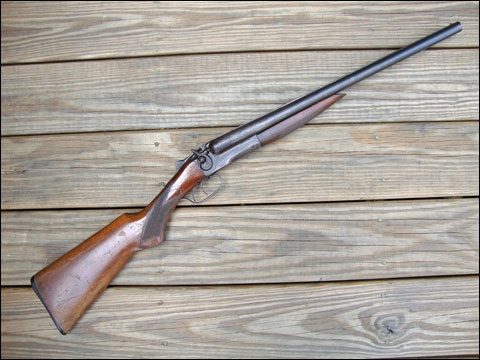
My Dad, who enjoyed hunting and shooting sports all of his life, passed away on June 5, 2013 at age 95. Franklin Lee Marten was living on the farm in the same house where he was born. He was still shooting skeet and hunting doves by his grandson’s pond the year before he died. When I was a little kid, my dad had a 16-gauge Stevens hammer gun. I remember handling it, but Dad sold it to his good friend and hunting buddy, Harry Moore, in 1949 or 1950 before I was old enough to shoot it.
One morning in October 2009 when my wife and I were back in central Illinois visiting our respective families, Dad and I ran into Harry while having coffee at the local restaurant. (Harry was in his early 80s at the time, but has since passed away.) In the course of our conversation, I asked about that Stevens. Harry said he still had it, although he had cut off the barrels to 20 inches many years ago “to shoot rats” at the local grain elevator where he worked. I let Harry know that if he ever wanted to sell it, I’d like to buy it.
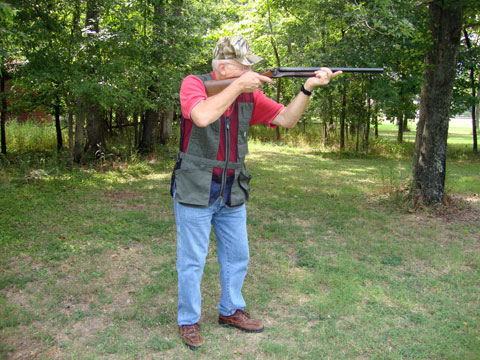 The author shooting his father’s 16-gauge Stevens hammer gun with cut-off barrels.
The author shooting his father’s 16-gauge Stevens hammer gun with cut-off barrels.
A few weeks later, I got an email saying it was not for sale, but if I still wanted it, he would be happy to give it to me. I offered to pay him, but he refused to take anything for it. I sent an email to Harry’s son, Greg, expressing my desire to at least give Harry what he had paid for the gun. Greg replied, “If you are going to try to pay dad for this gun, he is not going to take it. His sole intent is to see that you get the gun. That is what will make him happy!”
When I picked it up on our next trip to Illinois several months later, I was very surprised to see that the gun was still in pretty good condition. Although the finish on the frame was mostly gone, it locked up tight. There was still some bluing left on the barrels and a few flecks of surface rust, but no pitting. The bores were mirror bright. The stock and splinter forearm did have some handling marks and scratches, and the original varnish was nearly worn off. There were two small cracks in the left side of the stock behind the frame.
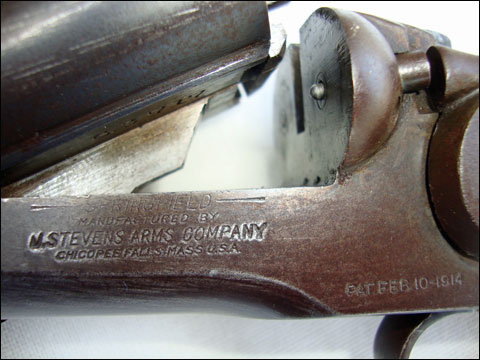 The Stevens receiver bears the patina of age from decades of rat shooting.
The Stevens receiver bears the patina of age from decades of rat shooting.
Stamped on the left side of the frame is “Springfield, manufactured by J. Stevens Arms Co., Chicopee Falls, Mass. Pat Feb 10, 1914.” “Proof Tested 16 ga.” is stamped on the top of the left barrel. “Serial No. 63717” is stamped on the frame and barrels. However, the forearm iron is stamped 63707.
I posted the information on a popular shotgun forum as well as 16-gauge web sites, and received a wealth of information from a reader. The gun is covered by Patent No. 1,086,378 that was issued on February 10, 1914, to G.S. Lewis and assigned to the J. Stevens Arms & Tool Co. of Chicopee Falls, Massachusetts. Stevens began using the Springfield name around 1930.
Prior to 1930 Stevens used the Riverside name for their lower priced line of guns. The gun first appeared in the J. Stevens Arms & Tool Co. General Catalog No. 54 as the Riverside Arms Company No. 215. The gun continued to be identified as a Riverside Arms Company No. 215 through Catalogue No. 57, dated 1927. However, in the J. Stevens Arms Company Wholesale Price Sheet dated January 2, 1930, and the No. 58 catalogue description in 1931, it was listed as a Springfield Arms Co. No. 215. A Springfield Arms Co. hammer gun, No. 215 was included in J. Stevens Arms Co.’s 1931 Wholesale and Retail Price Sheets, but was not listed in 1933, suggesting that Dad’s gun was likely made between 1930 and 1932.
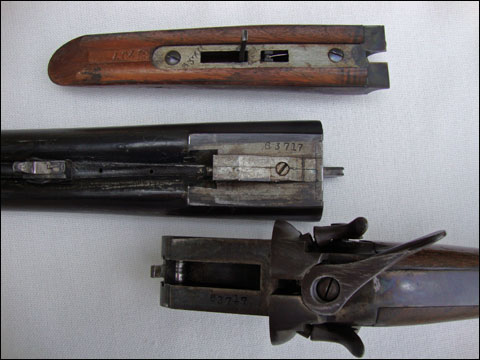 Proof marks and stampings still visible helped the author research his father’s Stevens.
Proof marks and stampings still visible helped the author research his father’s Stevens.
In 1928, the retail price of the Riverside No. 215 was $20.50. The price published in the Stevens January 2, 1931 Retail Price List was $18.50, and the 1932 Stoeger catalogue had the Springfield No. 215 priced at $22.45. However, the shotgun forum expert thought it probably could have been purchased for $18.00 or less.
Dad had previously told me he bought the gun new at George Rathgeber’s hardware store in Girard, Illinois sometime after 1932, but he couldn’t remember for sure what year. Mr. Rathgeber had acquired a confectionery and tobacco store around 1900 at the age of 27. According to Dad, by the 1930s Rathgeber’s store was selling “everything from bicycles to washtubs, including guns and ammo.”
Dad said the side by side had been on the shelf for a long time, and he paid $15.00 for it. That was considerably less than the expected list price, but undoubtedly a lot of money during the Depression. Dad said the Stevens was the first new gun he ever owned.
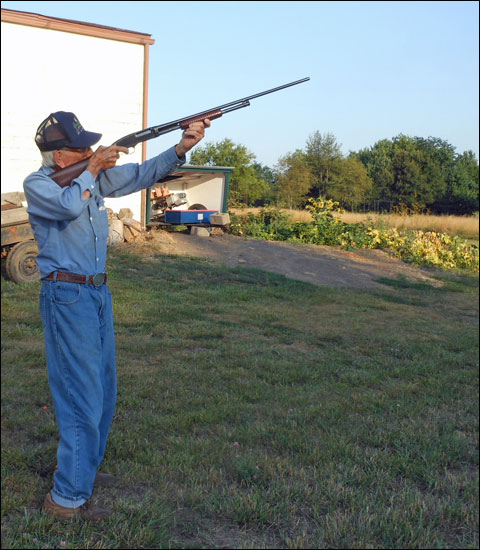 At age 95, the author’s father was still going strong with a shotgun.
At age 95, the author’s father was still going strong with a shotgun.
Dad also commented that it was the only gun that he ever shot a pheasant and his limit of quail on the same day, relating in great detail where he and his brother hunted that day, where they found the birds and how and where he shot his pheasant. (He said they were supposed to be “shucking corn,” but it was opening day of hunting season, and they decided to go hunting instead. Not sure what grandpa thought about that!”) Prior to getting the Stevens, he hunted with his father’s single-barrel 20 gauge.
Dad explained that during the 1930s the local hardware store where he bought the gun would often rent guns to customers by the day to go hunting. So, given the low price that he paid for it, it is possible that the gun Dad bought “new” could have been one of the store keeper’s rental guns, although dad doesn’t think so. Mr. Rathgeber also sold shotgun shells a few at a time, since during the Depression many of his customers could not afford to purchase a whole box. Dad’s hammer gun has 2-5/8-inch chambers, although in later years, dad said he only shot 2¾-inch shells with it.
Dad told the story about buying a box of 16-gauge “semi-smokeless” shells for 50 cents per box. (“Semi-smokeless powder was a mechanical blend of black powder and a small amount of nitrocellulose.) When dad asked if they were any good, Mr. Rathgeber (then in his 60s) remarked,” Look young man, your Grand Dad killed more game with black powder that you ever will.” Dad said that those “semi-smokeless” shells still generated a lot of smoke when fired.
Dad said that the front trigger on that side by side was hard to pull. He confided that he generally hunted with the right barrel cocked because he felt there was no way it would fire accidently. This was a real surprise and somewhat of a shock to me, because Dad was always such a stickler for safety, drilling into my brother and me to keep our finger off of the trigger with the safety on until we were ready to shoot.
I showed the gun to a friend who builds reproduction 18th century muskets and rifles and who does some repair work on vintage hammer guns. He expressed surprise at the gun’s relatively good condition, especially the bores. He commented that these so-called “hardware store” hammer guns in decent shape are pretty rare. They were relatively inexpensive, and farmers would keep the gun handy in the barn or shed where it could be quickly retrieved to kill rats, foxes and other varmints, not to mention stray dogs, going after the chickens or chasing livestock. Consequently, such working guns often received little care, and when the guns got too rusty or the bores became too pitted to shoot safely, they were scrapped.
The same day I got the gun from Dad’s old friend and hunting buddy, I took it out to the farm to show it to Dad and to see how it would shoot. I know I should have had a gunsmith check it over first, but it looked to be in such great shape that it didn’t dawn on me at the time that it might not be safe to shoot. Dad and I got out his portable trap to throw a few clays. We were both pleased with how well that old Stevens shot. Although there was an occasional “fail to fire” from light primer hits with the front trigger, we had no trouble breaking targets with it.
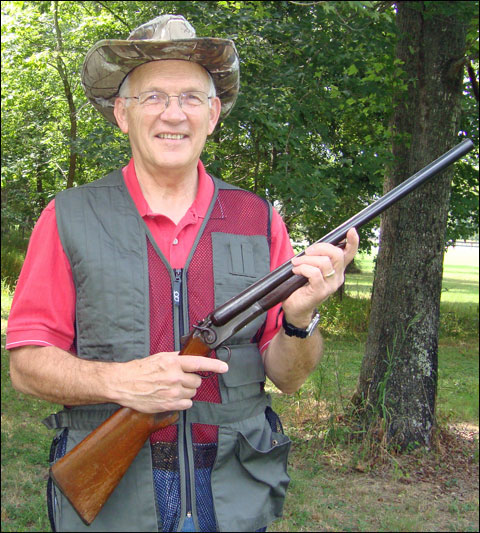 The author enjoying his father’s 16-gauge Stevens.
The author enjoying his father’s 16-gauge Stevens.
Later, back home in Virginia, I had it thoroughly checked out, cleaned and new hammer springs installed by a gunsmith. I patterned the gun with 1-ounce, 7½ Remington Game Loads. At 20 yards both barrels were close to POA, putting 90% -91% in a 30-inch circle. I shot a couple of rounds of wobble clays with it at a local club. The course consists of five stations in a slight arc even with the wobble trap. A single and two report pairs are shot from each station. I hit 19 out of 25 the first round and 20 out of 25 the second round. Not too bad when you consider that most shots are being taken between 20-35 yards. A few months later I shot two rounds of skeet with 1 oz. #7½ Fiocchi’s (I have found that they have softer primers than Federal, Winchesters or Remington game and target loads.). Shooting low gun I hit 22 out of 25 and 21 out of 25. I was beginning to think it might really be a decent quail gun. I actually did take it pheasant hunting, killing three pheasants the first day I hunted with it. By the way, the front trigger is still hard to pull!
We all have heard or asked questions like, “How much is that gun worth?” or “What is the value of that gun?” Value is ultimately in the eyes of the beholder, and to most folks, this gun, with its sawed-off 20-inch barrels, is probably not worth much dollar-wise. However, to me, getting it back after all those years, listening to my dad’s stories about hunting with it and he and I actually being able to shoot it together, that old Springfield-Stevens hammer gun is absolutely priceless.
Barry L. Marten, who now lives in Virginia, grew up on a farm in central Illinois where he hunted doves, rabbits, quail and pheasants with his dad and dad’s good friend, Harry Moore. Barry has collected and enjoyed shooting many different shotguns over the past 50 years. Other than his first Marlin Model 90 over/under given to him by his father in 1957, none holds a more personal connection than his dad’s old Springfield-Stevens No. 215 side-by-side hammer gun.


Comments